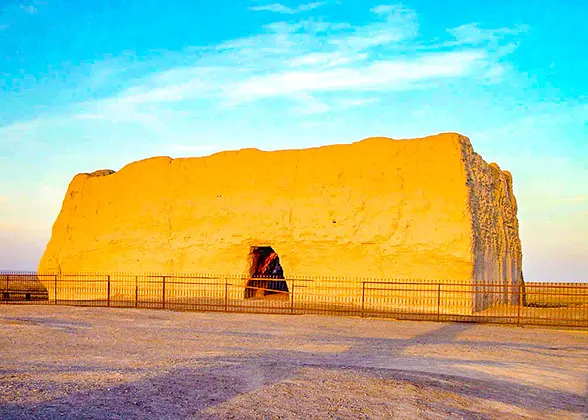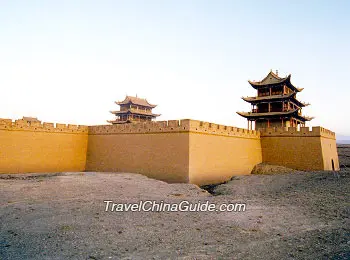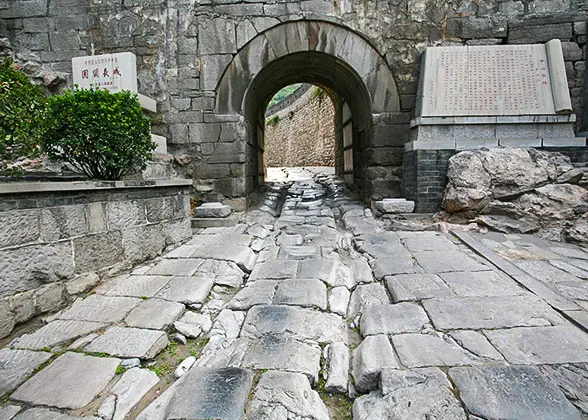Relation Between Great Wall & Silk Road
The Great Wall was like a giant stretching out his arm to protect the central plain of China in the past times. After the open-up of the Silk Road in 138 BC, it also served as the patron saint of this international trading route which extended from Xi'an to some European countries, and received prosperity in return as more and more merchants traveled along the route to exchange products, culture and religious ideas.
Great Wall Served As the Safeguard of the Silk Road
After the open-up of the Silk Road, the connection between the Han Dynasty (202 BC – 220 AD) and western regions was established. However, the northern frontier of the central plain was harassed by nomads at that time, especially desert areas in today's Gansu Province, and the safety of the Silk Road was also under threat. Therefore, the Han court decided to build Great Wall sections to ensure the peace and stability along the northern boundary. The wall also ensured the normal operation of the international trade along the Silk Road. Today, you can still find Great Wall ruins at Dunhuang Han Great Wall Site, Yumenguan, and Yangguan in Gansu. ![]() See more Why is the Great Wall of China important?
See more Why is the Great Wall of China important?
Some Great Wall Passes Became Vital Trading Ports along the Silk Road
Since 138 BC, more and more caravans shuttled between the central plain and western regions along the Silk Road. At that time, vital Great Wall passes such as Jiayuguan, Guguan and Yanmenguan, were crowded with people coming from different countries and wearing various ethnic clothes, and were brimmed with inns, restaurants and tea stalls. Plus booths and shops selling diverse products including silk, ceramics, tea, spice, carpets, jewelry, and gold and silver wares can be found everywhere along bustling streets of the passes, presenting a flourishing scene. Nowadays, the deeply rutted flagstone-paved path under the pass gates is the best proof of their past prosperity.
|
|
Similarities between Great Wall and Silk Road
1. Both are 'the World's Oldest' Of Their Kinds
The Great Wall is the world's oldest man-made building and its construction history can be traced back to the 7th century BC when the Chu State built a stretch of continuous wall from today's Hubei to Henan to defend against other kingdoms. The Silk Road is the earliest international trade route in the world, officially formed in 138 BC. Before that, there were already small-scale cross-border trade going on near the frontier and the King Mu of Zhou (1054 – 949 BC) even trekked westwards from Xi'an to Kyrghyzstan to present silk fabrics to masters of kingdoms along the way.
2. Both are 'the World's Longest' Of Their Kinds
 |
| Yumenguan along Silk Road |
The Great Wall of China extends for 21,196.18 kilometers (13,170.70 miles) and crosses over 15 regions in China from Liaoning to Xinjiang. There is no doubt it is the world's longest man-made structure, and speaking of trading route, the length of the Silk Road ranks the first in the world. It started from Xi'an and spanned for 7,000 kilometers (4,350 miles) westwards up to the Europe via four regions in China, namely Shaanxi, Gansu, Qinghai, and Xinjiang.
3. Both Were Inscribed In the World Heritage List by UNESCO
The Great Wall and Silk Road were listed as the World's Cultural Heritage in 1987 and 2014 respectively. Addition to the profound history and large span, the Great Wall witnessed numerous historical events and fierce battles along the frontier. As its construction work was carried out in nearly all the dynasties, this great wonder is also a treasure house of Chinese architectural features in different periods. As for the Silk Road, it brought people along the route closer to each other and promoted them to exchange not only products, but also culture and religious ideas.
4. Both Pass Jiayuguan, Yumenguan and Yangguan in Gansu
Once serving as the northern boundary line between the central plain and northern nomadic tribes, the Great Wall of China stands near the southern border of today's Inner Mongolia in the north of the country while the Silk Road stretches westwards from Xi'an in central China to Xinjiang. The two cultural lines finally join together at the Jiayuguan Pass in Gansu and continue to march westwards via Yumenguan and Yangguan.

